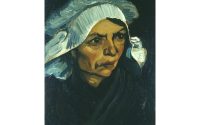‘Problemista’ Captures the Pain and Anguish of Struggling Artists and the Immigration Process
The premise of the recently released A24 film Problemista packs in a lot: an aspiring toy designer from El Salvador, who has only 30 days to lock down a new work visa sponsor, gets recruited to help a nightmare art critic stage an exhibition of egg paintings to secure the legacy of her cryogenically frozen husband.
That stuffed premise, however, provides a 98-minute container for writer, director, star, and producer Julio Torres’ funny and surreal observations of the art world and the US immigration process. Art students, gallery staff, archival storage facilities, frustrating databases, bureaucracy, and even bad arts journalism all get their licks.
“They all became ingredients for the for the movie,” the former Saturday Night Live writer told ARTnews. “I feel like, in a different world, I would be like working on a gallery or something.”
In Problemista, which opens wide on March 22, Alejandro (Torres) works at a cryogenics facility supervising the remains of painter Bobby Ascensio (RZA) while dreaming of designing toys with quirks and issues for Hasbro.
A workplace accident results in Alejandro being fired, immediately voiding his work visa and only giving him 30 days to find a new employer. Bobby’s hot-headed wife Elizabeth (Tilda Swinton) recruits Alejandro in her quest to fulfill her husband’s dream of a solo exhibition. If the two successfully stage a show and sell all of Bobby’s figurative paintings of eggs, Elizabeth will sponsor Alejandro’s new visa.
Torres wrote the character of Bobby specifically as a Black male painter based on his interactions with New School art students and observing how the art market treated people differently.
“Seeing how white artists charge for their work versus what non-white artists are told the work is worth has always been very intriguing to me,” Torres said. “If the hands that made it are white, then they do get the benefit of the doubt.”
“In Bobby, I really needed the audience to ask themselves, okay, are the eggs bad? Or did he never stand a chance?”
Prior to comedy, Torres’ worked at Neue Galerie in New York and as an art archivist for the estate of the late painter John Heliker “in a windowless vault in Newark, cataloguing Heliker’s papers“. These experiences would shape and inform multiple aspects of Problemista, including the sterile design of the cryogenics facility, and Elizabeth’s obsession with Filemaker Pro. The database software becomes a frequent source of tension between Elizabeth and Alejandro because Torres recognized it as a product that promises to solve everything but which is assigned to young people to figure out.
“I sort of felt that phenomenon repeating itself over and over again,” Torres said. “And I was so very intrigued by it.”
The pair’s multiple conflicts over Filemaker Pro also come from Torres’ empathetic view of the business side of the art industry, where people who loved painting suddenly have to figure out bureaucratic tasks like shipping, accounting, and content management.
Torres said he wrote Elizabeth’s monstrous behavior in Problemista after observing how many people in the art world—as well as in fashion and entertainment—are often deeply unhappy despite dealing with beauty and aesthetics all day. “There are so many grown up people who truly behave like children,” he said. “I just became mesmerized by the question of like, ‘Why is it that people who deal with beauty can be so monstrous?’ People just losing it over nothing.”
“Something’s gone wrong here,” he said.
That dichotomy is also explored through Elizabeth’s art criticism. Flashbacks in the film show Elizabeth reviewing Bobby’s work, prompting accusations he’s sleeping with her for press attention. Despite the couple’s open marriage, Elizabeth becomes jealous of her husband’s relationship with a promising student artist Dalia Park (Greta Lee). As a result, Elizabeth writes a scathing review of Dalia’s work in a Columbia University group show. “We see her as a sort of young, aloof, artist for a second, and then we see the toll that review had on her career,” Torres said.
It was shocking for Torres to observe how slowly visual artists produce work compared to the rapid pace of standup comedy. “Everything takes so much time,” he said. “You can pour decades into something, and then someone didn’t like that something and then it’s not good, it’s over,” he said with a laugh.
“Why did the person not like that something? Well, there’s a million reasons why they couldn’t have liked that something.”
In Problemista, the immigration process is represented through hourglasses filled with sand, illogical mazes, and people who disappear after learning their visa applications have been rejected. The scenes are meant to evoke the confusion, panic, and stress Torres felt after finishing college and frequently getting turned down for jobs due to his need for sponsorship.
“I have always, always been terrified of bureaucracy,” Torres told ARTnews. “When I was going through that process, it felt so, so scary, because it just felt like I have no control over it.”
Problemista‘s emotional portrayal of immigration is also a common experience among many international art students in the US. According to the latest statistics, non-American students make up 31% of the student body at the School at the Art Institute of Chicago, 35% at the Parsons School of Design, and 34% at the Rhode Island School of Design.
At its SXSW debut, the Problemista cast was asked if the film validated Elizabeth’s entitled, verbally abusive “Karen”-like behavior for how it inspires Alejandro to stand up for himself and his ideas. But Torres compared Elizabeth to a lion in captivity “who’s just like, roaring through the cage, and doesn’t really see any system being in her favor, even though that is maybe inaccurate given her her race or her privilege or whatever.”
“I don’t think that she’s comfortably nestled in the systems of oppression,” he said. “Or she doesn’t see it that way, at least.”
Since Problemista was first shown last April, immigration has become an even more contentious topic in the US. But Torres is still hopeful that American audiences will stop thinking of films like Problemista as niche and be more open to empathizing with very different experiences from their own, surreal or otherwise.
One of the biggest positive signs: Past Lives, another bilingual movie about immigration distributed by A24 starring Lee, is currently an Academy Award nominee for Best Picture.
“I like that now, mainstream US is like, ‘Oh, okay, so there is a world beyond the worlds that that are usually presented to us.’”



